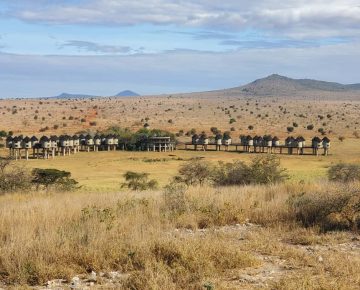Kisumu Impala Sanctuary
Located on the shores of Lake Victoria, Kisumu Impala Sanctuary is a stunning biosphere that showcases the rich wildlife and natural beauty of Kenya. Established in 1986, this sanctuary covers an area of approximately 165 hectares. More so, it is an integral part of the larger Kisumu area. It is not only a haven for a variety of animal species but also a vital ecological zone that plays a crucial role in conservation efforts.
A Glimpse into the Sanctuary’s History
The Kisumu Impala Sanctuary was established primarily to provide a refuge for the impala. An impala is a medium-sized antelope that is native to Africa. The sanctuary was founded in response to the declining population of these graceful animals due to habitat destruction and hunting. Over the years, the sanctuary has expanded its mission to protect other species and their habitats, becoming a critical area for wildlife conservation.

Biodiversity and Wildlife
Kisumu Impala Sanctuary is home to a diverse range of wildlife, making it a prime destination for ecotourism. The sanctuary boasts over 100 species of birds, including the vibrant African Fish Eagle and the striking Great Egret. Birdwatchers flock to the sanctuary to catch a glimpse of these avian wonders, especially during the migratory seasons.
In addition to birdlife, the sanctuary is home to various mammals, including the iconic impala, which can often be seen grazing in the open grasslands. Other notable species include zebra, giraffes, and various types of monkeys such as the Vervet monkey. The sanctuary’s lush vegetation and varied landscapes provide the perfect backdrop for these animals, creating a unique ecosystem that thrives on biodiversity.
Conservation Efforts in the Kisumu Impala Sanctuary
The sanctuary plays a vital role in conservation, not just for the impala but for the entire ecosystem. Conservationists at Kisumu Impala Sanctuary engage in various activities aimed at preserving the natural environment and protecting endangered species. These efforts often include habitat restoration, anti-poaching patrols, and community education programs.
One of the key initiatives involves working with local communities to promote sustainable practices that protect wildlife while providing economic benefits. By engaging local populations in conservation efforts, the sanctuary fosters a sense of ownership and responsibility towards the environment.
Ecotourism and Community Involvement
Kisumu Impala Sanctuary is an excellent example of how ecotourism can benefit both wildlife and local communities. The sanctuary attracts thousands of visitors each year, contributing to the local economy through entrance fees, guided tours, and related activities. This influx of tourists supports local businesses, including hotels, restaurants, and souvenir shops.
Moreover, the sanctuary collaborates with local communities to provide employment opportunities and training in sustainable tourism practices. This not only helps to alleviate poverty but also encourages residents to participate in conservation efforts, ensuring that they have a stake in the preservation of their natural heritage.
Activities done at the Sanctuary
Visitors to Kisumu Impala Sanctuary can engage in a variety of activities that enhance their experience and appreciation of the natural world. One of the most popular activities is guided nature walks, where knowledgeable guides lead groups through the sanctuary, sharing insights about the flora and fauna.
For those interested in bird watching, there are designated birding trails that provide opportunities to spot numerous bird species in their natural habitats. Photography enthusiasts will also find plenty of opportunities to capture stunning images of wildlife and the breathtaking landscapes surrounding the sanctuary.
Additionally, the sanctuary offers picnic areas where families and groups can enjoy a day out in nature. The peaceful atmosphere and scenic views of Lake Victoria make it an ideal spot for relaxation and reflection.
Challenges Facing the Kisumu Impala Sanctuary
Despite its many successes, Kisumu Impala Sanctuary faces several challenges that threaten its ecological integrity. One of the most pressing issues is habitat degradation due to human activities such as urban expansion and agriculture. As the surrounding areas develop, the sanctuary’s natural habitats are at risk of being encroached upon, which can lead to a decline in wildlife populations.
Furthermore, climate change poses significant risks to the delicate ecosystems within the sanctuary. Changes in weather patterns can affect the availability of food and water resources for wildlife. This makes it essential for conservationists to adapt their strategies to mitigate these impacts.
The Future of Kisumu Impala Sanctuary
The future of Kisumu Impala Sanctuary hinges on continued conservation efforts and community involvement. Ongoing education programs aimed at raising awareness about the importance of biodiversity and sustainable practices will be crucial for fostering a culture of conservation among local populations.
Collaboration with governmental and non-governmental organizations can also enhance the sanctuary’s capacity to address challenges effectively. By securing funding and resources, conservationists can implement more robust programs that protect wildlife and restore habitats.
Are you ready to visit Kisumu Impala Sanctuary?
Kisumu Impala Sanctuary is more than just a wildlife refuge. It is a testament to the power of conservation and community engagement. It boasts rich biodiversity and stunning landscapes. Additionally, the sanctuary offers a unique opportunity to experience the beauty of nature while contributing to its preservation.
As visitors explore the sanctuary, they are reminded of the delicate balance between human activity and wildlife conservation. By supporting Kisumu Impala Sanctuary, individuals can play a role in ensuring that this natural treasure remains a vibrant ecosystem for future generations. Whether it’s through ecotourism, community involvement, or conservation efforts, every action contributes to the protection of this remarkable sanctuary and the wildlife it harbors















